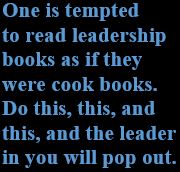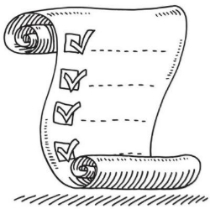 So many books on leadership and management feature lists. There’s Edwards Deming’s “14 Management Principles,” Steven Covey’s “7 Habits of Highly Effective People,” Robert Quinn’s “8 Seed Thoughts.”
So many books on leadership and management feature lists. There’s Edwards Deming’s “14 Management Principles,” Steven Covey’s “7 Habits of Highly Effective People,” Robert Quinn’s “8 Seed Thoughts.”
Saul Alinsky’s Rules for Radicals contains 11 rules on “the ethics of means and ends” and 13 rules on tactics. Even Robert Greenleaf’s essay The Servant as Leader, at least the way I read it, contains eight qualities or actions of servant leadership. (Go to the Lead Post in my series on this important essay to see my list of what I think his list is!)
What does this communicate about the process of becoming a leader? Many leadership books read like stereotypical self-help books, and, more important, one is tempted to read them as if they were cook books. Do this, this, and this, and out will pop the leader in you. Yet so many of these books also talk about more mysterious processes, processes that may have yielded lists but actually start with deep intuitions and feelings for what is right. Robert Quinn’s book Change the World: How Ordinary People Can Accomplish Extraordinary Results throws irony on top of paradox by starting each chapter with  quotes from Jesus, Gandhi, and Martin Luther King, Jr. “Ordinary People”? But as he pushes his take on deep change—his Advanced Change Theory (ACT), with its “8 Seed Thoughts”—he says, in a section titled “The Inaccessibility of ACT”: “Understanding of the transformational process does not emanate from logical analysis…it does not come from external authority of the theological institution. It emanates from principled living and higher levels of moral reason…”—this last reference stemming from another list, Kohlberg’s ubiquitous “Six Stages of Moral Reasoning.”
quotes from Jesus, Gandhi, and Martin Luther King, Jr. “Ordinary People”? But as he pushes his take on deep change—his Advanced Change Theory (ACT), with its “8 Seed Thoughts”—he says, in a section titled “The Inaccessibility of ACT”: “Understanding of the transformational process does not emanate from logical analysis…it does not come from external authority of the theological institution. It emanates from principled living and higher levels of moral reason…”—this last reference stemming from another list, Kohlberg’s ubiquitous “Six Stages of Moral Reasoning.”
At one point even crusty, hard-nosed Saul Alinsky, defining the qualities of a great organizer, turns to Adam Smith’s The Money Game, where Smith describes a great fund manager: “It is personal intuition, sensing patterns of behavior. There is always something unknown, undiscerned…You can’t just graduate an analyst into managing funds. What is it the good managers have? It’s a kind of locked-in concentration, an intuition, a feel, nothing that can be schooled. The first thing you have to know is yourself.” In “Art, Rhythm, Intuition, and Social Change” I wrote of how important “sensing patterns” was to a list of qualities and actions Robert Greenleaf’s servant leader had to have. And as to how he came up with the idea of servant leadership itself (and started a whole field of leadership thinking), Robert Greenleaf says, “I didn’t get the notion of the servant as leader from conscious logic. Rather it came to me as an intuitive insight. And I do not see what is relevant from my own searching and experience in terms of a logical progression from premise to conclusion.”
 It’s a constant, nagging question. How much can anything, let alone leadership, be taught? For years I’ve told my writing students that their ability to write will come 40% from just writing themselves, 40% from reading, and only 20% from what I teach them—and that last could be a generous estimate. From just writing and reading will come a feeling for the resonances of words, the rhythms of sentences, the pace of an entire composition. And these percentages don’t take into account what may be the most important thing of all: what, as Quinn might say, “emanates from principled living.” Here “principled living” could be taken more broadly as meaning the intensity with which writers live and feel the “human condition.” This last phrase—also mysterious—perhaps finally boils down to how much empathy writers have for others…and for themselves.
It’s a constant, nagging question. How much can anything, let alone leadership, be taught? For years I’ve told my writing students that their ability to write will come 40% from just writing themselves, 40% from reading, and only 20% from what I teach them—and that last could be a generous estimate. From just writing and reading will come a feeling for the resonances of words, the rhythms of sentences, the pace of an entire composition. And these percentages don’t take into account what may be the most important thing of all: what, as Quinn might say, “emanates from principled living.” Here “principled living” could be taken more broadly as meaning the intensity with which writers live and feel the “human condition.” This last phrase—also mysterious—perhaps finally boils down to how much empathy writers have for others…and for themselves.
How do you develop that? There’s certainly lots of books, each containing lists pointing to more lists in a nearly infinite regression, all supposed to guide us there. But maybe only 20% there. And that’s IF we understand that those lists are finally just approximations, more or less honest, that could help lead us to more difficult, mysterious, powerful places in our selves.
♦ This article is part of a series on John Greenleaf’s The Servant as Leader. Go to the series’ Lead Post.
♦ Go to the main page for Leadership for Social Change.